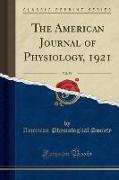- Start
- The American Journal of Physiology, 1921, Vol. 56 (Classic Reprint)
The American Journal of Physiology, 1921, Vol. 56 (Classic Reprint)
Angebote / Angebote:
Excerpt from The American Journal of Physiology, 1921, Vol. 56In the experiments in which cardiometer and blood pressure readings were Obtained, the animals were morphinized, etherized and the, chest opened under artificial respiration. The cardiometer was of the glass bulb type with a perforated rubber membrane to fit around the auriculo ventricular groove. Care was used in its application so that the blood ¿ow into the ventricle might not be Obstructed. Systolic and diastolic pressures were Obtained with maximal and minimal valves. Venous pressure was determined by inserting a sound into the vena cava through the femoral vein and balancing the pressure against a manom eter filled with salt solution.X-ray examination after hemorrhage. According to the known reao tions to hemorrhage which have already been mentioned, it has been generally thought that following a rapid loss Of blood there is at once, or certainly within a few seconds, a peripheral vasoconstriction and an increased heart rate. Since the blood volume is decreased these reactions would seem to necessitate a decreased cardiac output per beat. This could be brought about by diminution of systole, or as more naturally and usually supposed, by a decrease in diastolic size, that is in cardiac filling.X-ray photographs of the heart before and after hemorrhage Show, however, contrary to the Opinion just expressed, that the diastolic size of the heart is maintained even after the loss of large quantities of blood. In twenty-one experiments, each with from two to six hemorrhages, the heart did not decrease more than 5 per cent, a figure we have allowed for unavoidable variations in the method, until the loss of blood on an average equaled 2 per cent Of the body weight. The lowest figure was per cent and the highest per cent. In the dog this represents a loss of from 11 to 28 per cent of the blood volume. In table 1 may be seen a summary Of nine of these experi ments. The others were quite Similar but have not been included for the sake Of space. Figures 1 and 2 present the data of two of the experiments not included in table 1. The steady decrews in blood volume is Sharply contrasted with the sudden reduction in diastolic heart size which occurs when about 20 per cent of the blood is lost, and which would seem to indicate the breakdown of some protective mechanism.About the PublisherForgotten Books publishes hundreds of thousands of rare and classic books. Find more at www.forgottenbooks.comThis book is a reproduction of an important historical work. Forgotten Books uses state-of-the-art technology to digitally reconstruct the work, preserving the original format whilst repairing imperfections present in the aged copy. In rare cases, an imperfection in the original, such as a blemish or missing page, may be replicated in our edition. We do, however, repair the vast majority of imperfections successfully, any imperfections that remain are intentionally left to preserve the state of such historical works.
Folgt in ca. 5 Arbeitstagen
